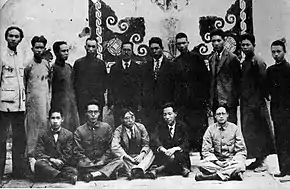Korean People's Association in Manchuria
Korean People's Association in Manchuria (KPAM, August 1929 – September 1931)[1] was an autonomous anarchist zone in Manchuria near the Korean borderlands,[1] populated by two million Korean migrants.[2] It was also known as Shinmin Prefecture[1] or Korean Anarchist Federation in Manchuria. The society was constructed upon principles of stateless communism, operating within the framework of a gift economy based upon mutual aid.
Korean People’s Association in Manchuria 재만한족총연합회 / 在滿韓族總聯合會 | |||||||||
|---|---|---|---|---|---|---|---|---|---|
| 1929–1931 | |||||||||
.png.webp) Map of Mudanjiang Prefecture | |||||||||
| Status | Historically unrecognized autonomous confederation | ||||||||
| Capital | Mudanjiang (de facto) | ||||||||
| Common languages | Korean | ||||||||
| Historical era | Interwar period | ||||||||
• Established | August 1929 | ||||||||
| September 1931 | |||||||||
| |||||||||
| Korean People’s Association in Manchuria | |
 Founding members of the KPAM in 1928 | |
| Korean name | |
|---|---|
| Hangul | 재만한족총연합회 |
| Hanja | 在滿韓族總聯合會 |
| Revised Romanization | Jaeman Hanjok Chongyeonhaphoe |
| McCune–Reischauer | Chaeman Hanjok Ch'ongyŏnhaphoe |
| Korean Anarchist Federation in Manchuria | |
| Hangul | 재만조선무정부주의자연맹 |
| Hanja | 在滿朝鮮無政府主義者聯盟 |
| Revised Romanization | Jaeman Joseon Mujeongbujuuija Yeonmaeng |
| McCune–Reischauer | Chaeman Chosŏn Mujŏngbujuŭija Yŏnmaeng |
| Shinmin Prefecture | |
| Hangul | 신민부 |
| Hanja | 新民府 |
| Revised Romanization | Sinminbu |
| McCune–Reischauer | Sinminbu |
History
Background
Japan had invaded Korea in 1894, under the pretext of protecting Korea from China, after the Joseon dynasty invited China to help them put down the Donghak Peasant Revolution. Korea was finally annexed into the Japanese Empire in 1910. During World War I, Zhang Zuolin (a former bandit and supporter of Yuan Shikai), established himself as a powerful warlord with influence over most of Manchuria. He was inclined to keep his Manchu army under his control and to keep Manchuria free of foreign influence.[3]
The March 1st Movement involved 1,500 demonstrations and 2 million protesters. The Japanese Empire responded with brutal repression: 7,500 were killed and 16,000 wounded. As a result, many Korean anarchists fled to Manchuria and other parts of China.[4]
Meanwhile, Zuolin was rising through the ranks of the Republic of China, eventually establishing himself as President of the Republic of China of the Beiyang government. However, Japan successfully assassinated Zuolin, leaving behind a power vacuum that would be filled by the rival KMT and CCP, but also presented an opportunity for the numerous Korean anarchists now organised in Manchuria.[3]
Foundation of the Autonomous Zone
The Korean Anarchist Federation, founded in 1929,[1] sunk deep roots among the 2 million Koreans in Manchuria.[4] The KPAM formed as a result of close collaboration between the Korean Anarchist Federation in Manchuria (KAFM) and the Korean Anarcho-Communist Federation (KACF)[4]
The KPAM was part of the "autonomous village movement"[5] where anarchists and others, instead of focusing on some distant revolution or nationalist development plan, focused on meeting the material needs of the people and each other.[6] This was part of a coming together of nationalist and anarchist people as well as Korean peasants in partial response to hostilities from Imperial Japan and Chinese Nationalist forces. Though initially separate, the two main affinities came together in a form of organization called "no rule" where social organization was based on individual liberty and mutual aid.[6]
Repression
On January 20, 1930, the anarchist general Kim Chwa-chin was assassinated by an Imperial agent while doing repair work on a rice mill.[4] After the assassination of another anarchist leader, Kim Jong-jin the following year, the anarchist movement in Manchuria and Korea became subject to massive repression.[6][7] Japan sent armies to attack KPAM from the south, while pro-Kuomintang forces attacked from the north. With the Japanese invasion of Manchuria, many Korean anarchists went underground and KPAM ceased to exist as a distinct political entity. The KAF-M and KACF continued to fight in China alongside the Chinese communists against Japanese Imperialism until 1945, but Anarchist Shinmin was no more.[1]
Government
Decision-making within the KPAM territories was based on the anarchist ideals of participatory democracy with the society being dominated by village assemblies and various council systems to create a grassroots society.[8]
Economy
The KPAM drew heavily from the economic theories of libertarian socialism and established give-away shops, worker cooperatives and democratic schools throughout their territories. Regional councils were also created.[1] In the meanwhile, they appointed higher-level staff (who only received minimum wage) from the top down, with lower levels of officials regionally chosen. Organisation and propaganda teams worked with agitating the populace, both to get the farmer's support and to get them to create independent village assemblies and committees. Seemingly, these teams were welcome to almost everywhere they went, with no major incidents being noted.[4]
The KPAM operated without currency, private property, and any kind of class structure. Thus, the territory functioned as an example for anarcho-communist groups throughout Manchuria.
Military
The army was composed mainly of experienced military officers, former soldiers and peasant guerillas who were trained at local guerilla schools.[1]
References
- "Cartography of Revolutionary Anarchism". Anarchy in Action. Retrieved 2 March 2017.
- MacSimoin, Alan. "A Talk by Alan MacSimoin to the Workers' Solidarity Movement, Dublin Branch in September 1991". Anarchy Archives. Retrieved 2 March 2017.
- Behr (1987), p. 168.
- Alan MacSimoin. "The Korean Anarchist Movement" (PDF). The Anarchist Library. Retrieved 2019-11-05.
- "Korean Anarchists Under Martial Law". libcom.org. Retrieved 5 November 2019.
- Dongyoun, Hwang (2016). Anarchism in Korea: independence, transnationalism, and the question of national development, 1919–1984. Albany. ISBN 9781438461670. OCLC 959978940.
- Ha Ki-Rak (1986). History of the Korean anarchist movement (PDF). Seoul: Anarchist Publishing Committee. p. 25.
- Gelderloos, Peter. (2015). Anarchy works (PDF). Ak Press. ISBN 978-1909798052. OCLC 951644634.
Sources
- Behr, Edward (1987), The Last Emperor, Bantam Books, ISBN 0553344749